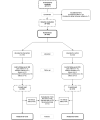Effectiveness of an mHealth Intervention Combining a Smartphone App and Smart Band on Body Composition in an Overweight and Obese Population: Randomized Controlled Trial (EVIDENT 3 Study)
- PMID: 33242020
- PMCID: PMC7728540
- DOI: 10.2196/21771
Effectiveness of an mHealth Intervention Combining a Smartphone App and Smart Band on Body Composition in an Overweight and Obese Population: Randomized Controlled Trial (EVIDENT 3 Study)
Abstract
Background: Mobile health (mHealth) is currently among the supporting elements that may contribute to an improvement in health markers by helping people adopt healthier lifestyles. mHealth interventions have been widely reported to achieve greater weight loss than other approaches, but their effect on body composition remains unclear.
Objective: This study aimed to assess the short-term (3 months) effectiveness of a mobile app and a smart band for losing weight and changing body composition in sedentary Spanish adults who are overweight or obese.
Methods: A randomized controlled, multicenter clinical trial was conducted involving the participation of 440 subjects from primary care centers, with 231 subjects in the intervention group (IG; counselling with smartphone app and smart band) and 209 in the control group (CG; counselling only). Both groups were counselled about healthy diet and physical activity. For the 3-month intervention period, the IG was trained to use a smartphone app that involved self-monitoring and tailored feedback, as well as a smart band that recorded daily physical activity (Mi Band 2, Xiaomi). Body composition was measured using the InBody 230 bioimpedance device (InBody Co., Ltd), and physical activity was measured using the International Physical Activity Questionnaire.
Results: The mHealth intervention produced a greater loss of body weight (-1.97 kg, 95% CI -2.39 to -1.54) relative to standard counselling at 3 months (-1.13 kg, 95% CI -1.56 to -0.69). Comparing groups, the IG achieved a weight loss of 0.84 kg more than the CG at 3 months. The IG showed a decrease in body fat mass (BFM; -1.84 kg, 95% CI -2.48 to -1.20), percentage of body fat (PBF; -1.22%, 95% CI -1.82% to 0.62%), and BMI (-0.77 kg/m2, 95% CI -0.96 to 0.57). No significant changes were observed in any of these parameters in men; among women, there was a significant decrease in BMI in the IG compared with the CG. When subjects were grouped according to baseline BMI, the overweight group experienced a change in BFM of -1.18 kg (95% CI -2.30 to -0.06) and BMI of -0.47 kg/m2 (95% CI -0.80 to -0.13), whereas the obese group only experienced a change in BMI of -0.53 kg/m2 (95% CI -0.86 to -0.19). When the data were analyzed according to physical activity, the moderate-vigorous physical activity group showed significant changes in BFM of -1.03 kg (95% CI -1.74 to -0.33), PBF of -0.76% (95% CI -1.32% to -0.20%), and BMI of -0.5 kg/m2 (95% CI -0.83 to -0.19).
Conclusions: The results from this multicenter, randomized controlled clinical trial study show that compared with standard counselling alone, adding a self-reported app and a smart band obtained beneficial results in terms of weight loss and a reduction in BFM and PBF in female subjects with a BMI less than 30 kg/m2 and a moderate-vigorous physical activity level. Nevertheless, further studies are needed to ensure that this profile benefits more than others from this intervention and to investigate modifications of this intervention to achieve a global effect.
Trial registration: Clinicaltrials.gov NCT03175614; https://clinicaltrials.gov/ct2/show/NCT03175614.
International registered report identifier (irrid): RR2-10.1097/MD.0000000000009633.
Keywords: body fat distribution; diet records; electric impedance; mobile app; obesity; telemedicine; weight control.
©Cristina Lugones-Sanchez, Maria Antonia Sanchez-Calavera, Irene Repiso-Gento, Esther G Adalia, J Ignacio Ramirez-Manent, Cristina Agudo-Conde, Emiliano Rodriguez-Sanchez, Manuel Angel Gomez-Marcos, Jose I Recio-Rodriguez, Luis Garcia-Ortiz, EVIDENT 3 Investigators. Originally published in JMIR mHealth and uHealth (http://mhealth.jmir.org), 26.11.2020.
Conflict of interest statement
Conflicts of Interest: None declared.
Figures




References
-
- World Health Organization. Obesity and overweight. [2020-02-15]. http://www.who.int/news-room/fact-sheets/detail/obesity-and-overweight.
-
- Hernáez Á, Zomeño MD, Dégano IR, Pérez-Fernández S, Goday A, Vila J, Civeira F, Moure R, Marrugat J. Exceso de peso en España: situación actual, proyecciones para 2030 y sobrecoste directo estimado para el Sistema Nacional de Salud. Revista Española de Cardiología. 2019 Nov;72(11):916–924. doi: 10.1016/j.recesp.2018.07.009. - DOI - PubMed
-
- Lavie CJ, McAuley PA, Church TS, Milani RV, Blair SN. Obesity and cardiovascular diseases: implications regarding fitness, fatness, and severity in the obesity paradox. J Am Coll Cardiol. 2014 Apr 15;63(14):1345–54. doi: 10.1016/j.jacc.2014.01.022. https://linkinghub.elsevier.com/retrieve/pii/S0735-1097(14)00334-9 - DOI - PubMed
Publication types
MeSH terms
Associated data
LinkOut - more resources
Full Text Sources
Medical
Miscellaneous

